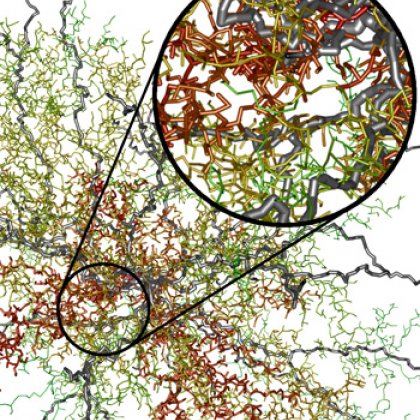
Two UQ Science researchers have proved two famous physical laws that have been widely used for the past 25 years do not always work.
Dr Tony Roberts and PhD student Christophe P. Haynes, from the School of Maths and Physics, showed the fractal-Einstein and Alexander-Orbach laws can fail in some instances, and have derived a new law to replace them.
Dr Roberts said this new discovery had implications for predicting material properties; how disease spreads through society; mapping how wild animals forage for food; and improving the internet.
“We demonstrated unequivocally that two 'exact' foundational laws of fractal science, which have been cited over 2000 times in the scientific literature, can fail for a class of fractals,” he said.
“These are the first definitive counter examples to these laws.
“Given that our key equation solves a number of old and new problems, we believe we have discovered a 'missing' equation from fractal physics that will have important implications.”
Dr Roberts said the laws in question were used to describe how particles diffuse in complex environments, which lies at the heart of range of big scientific questions.
“Imagine you have an animal that can search for food in one of two valleys, one narrow, with many side branches, and the other wide, with only a few side tracks,” he said.
“Under the old laws, the probability of the animal locating food in either valley was equal, regardless of which was easier. Intuitively we can see that this just isn’t the case.
“But our new law takes into account the differences in the valleys, predicting the time it takes for the animal to find food is significantly longer in the difficult valley.”
Dr Roberts said particles in diffuse in complex environments in much the same way, choosing the easiest path, and so their spread was not uniform, as the old laws predicted.
He said the discovery came from a bit of good fortune and a lot of hard work.
“It’s quite rare to turn over widely accepted laws like this, and, as often occurs in science, it came out of curiosity driven research," he said.
"The history of it was that my PhD student had been working on the theory of some networks when he came to me in October last year with calculations which didn’t obey this law.
“Around November we confirmed all our results and discovered that we had indeed violated this law, so our mindset changed from checking our work to essentially saying, what’s going on here? There must be something new going on here.”
Dr Roberts and Mr Haynes then went back through the 25-year-old derivations of the laws to examine their underlying assumptions.
“We were tearing our hair out because we were staring into the unknown, we were considering behaviour that people hadn’t conceived of before,” he said.
“So it took 7 or 8 months to work it into a new law and get it published but it’s done.
“It’s a really lovely story, I mean I’ve been doing science for 20 years and I’ve never been associated with anything like this.”
Dr Roberts said although the new law has direct implications for the properties of materials with fractal structure, the laws of physical networks may help in providing a more accurate mathematical model of the spread of disease.
“Current laws would essentially show that for two places that were equidistant (from Brisbane), so that would be I guess Mackay and Sydney, that the transmission rates would be the same,” he said.
“But our work shows that it’s possible for the disease to spread more in particular directions where there are a greater number of connections.
“While you would expect you would get greater disease transfer where there were greater connections, the current laws don’t actually show that – ours does.”
The research, titled Generalisation of the fractal Einstein law relating conduction and diffusion on networks, will be published in the July 17 issue of Physical Review Letters. An advance copy will be available on the journal’s website on July 14.
Media: Dr Tony Roberts, School of Maths and Physics (07 33653263 or apr@maths.uq.edu.au) or Travis Taylor, Faculty of Science (07 33658598 or t.taylor1@uq.edu.au).
.jpg)

